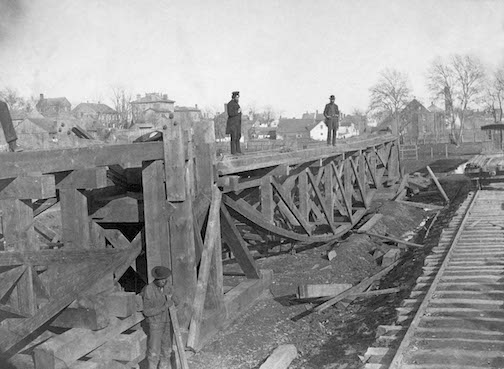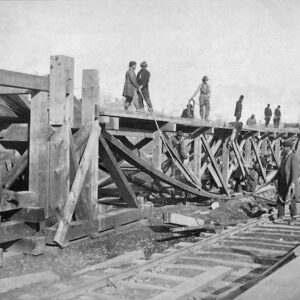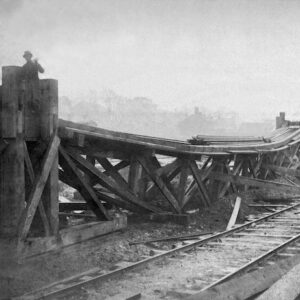| Credit: | by Russell (Andrew J.) |
|---|---|
| Date: | 1863.02-03 |
| Negative Size: | 6.5 in. x 8.5 in. |
| Locations & Lines: | Alexandria VA; Orange & Alexandria Railroad (O&A); Virginia |
| Military Units: | US Military Railroads (USMRR); US Army |
| Persons: | Haupt (Herman) |
| Sources: | J. Paul Getty Museum; Lehigh University; Library of Congress |
$5.99
File Details: AAAOm, 600 DPI, TIFF, Original Photograph, 16.5 Mb
Image ID: AAAO
The man standing at the center of the truss appears to be Herman Haupt.
Haupt, United States Military Railway Department. Construction And Transportation. No. 14. Experimental Suspension Trusses of Boards. – The experiments on this truss give very important results, and indicate the possibility of applying the principles even to railway bridges. The supports of the bridge consisted of two catenaries, each of six one-inch boards, twelve inches wide; the spans was 100 feet, versed sine 10 feet. The boards were nailed together at intervals of 4 inches, with tenpenny nails; and after the catenary was formed, cut spikes were driven through. The anchorage, which was not very secure, gave way with 84,000 pounds, but the boards were not pulled apart. The experiment will be repeated by coating the surfaces of the boards with pitch, compressing them with half-inch bolts one foot apart, and driving spikes at intervals of four inches. It is believed that this arrangement will possess extraordinary powers of resistance, and the combination being impervious to water, will also possess great durability.
In constructing a suspension bridge upon this principle, to replace a bridge of one or more spans that has been destroyed, three of the layers of boards which form the catenaries should be nailed together on the bank at one end of the bridge, supported, if necessary, by rollers, and drawn into place across the opening by a cable and capstan on the opposite side. When the catenary of three boards is placed, it will form a runway across the opening; other boards are then added, taking care to break joints at equal distances; holes are then bored, bolts inserted and tightly screwed, and lastly the spikes are driven. The anchorage is secured by spreading the boards at the ends by means of wedges, in the shape of a fan, to prevent it from pulling through between the timbers which embrace it; or in several other ways secure anchorage may be obtained. As boards can be carried by men for several miles, this mode of construction for military bridges may sometimes possess great advantages. A very important application of this principle may be made to the construction of a board suspension bridge for ordinary military purposes. The board catenaries drawn across the stream, anchored to posts, and floating on the water, may be raised, at intervals of 30 or 40 feet, by means of a scow and trestles placed under, giving as many points of support as may be considered necessary. Such a bridge could be constructed with great rapidity.



